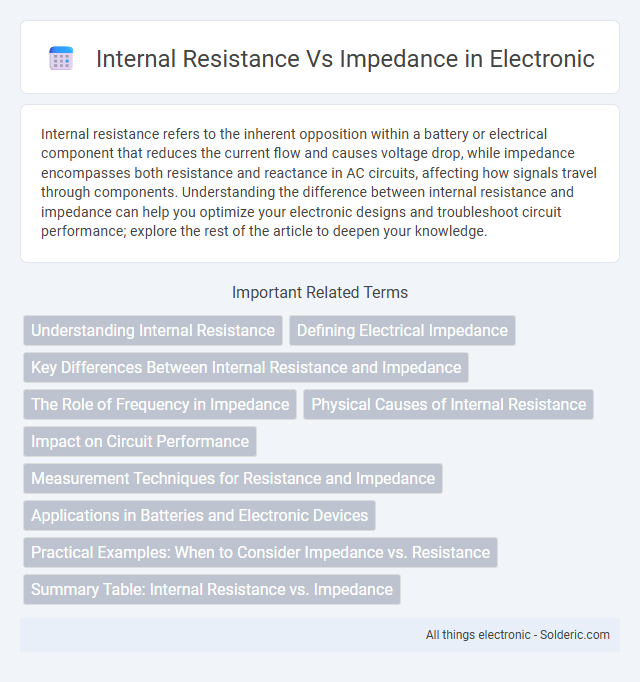Internal resistance refers to the inherent opposition within a battery or electrical component that reduces the current flow and causes voltage drop, while impedance encompasses both resistance and reactance in AC circuits, affecting how signals travel through components. Understanding the difference between internal resistance and impedance can help you optimize your electronic designs and troubleshoot circuit performance; explore the rest of the article to deepen your knowledge.
Comparison Table
| Feature | Internal Resistance | Impedance |
|---|---|---|
| Definition | Resistance within a component or battery opposing direct current (DC) | Total opposition to alternating current (AC), including resistance and reactance |
| Type of Current | Direct Current (DC) | Alternating Current (AC) |
| Components | Purely resistive | Resistive + Reactive (capacitive or inductive) |
| Frequency Dependence | Independent of frequency | Varies with frequency |
| Measurement Unit | Ohms (O) | Ohms (O), complex number with magnitude and phase |
| Effect on Circuit | Causes power loss and voltage drop in DC circuits | Affects amplitude and phase of AC signals |
Understanding Internal Resistance
Internal resistance refers to the inherent opposition within a power source, such as a battery, that decreases the effective voltage output when current flows. Unlike impedance, which encompasses resistance, inductance, and capacitance in AC circuits, internal resistance specifically addresses the DC resistance inside the component. Measuring internal resistance is essential for evaluating battery efficiency, predicting voltage drops, and optimizing performance in electronic devices.
Defining Electrical Impedance
Electrical impedance is a complex quantity representing the opposition that a circuit presents to the flow of alternating current (AC), combining both resistance and reactance components. Unlike internal resistance, which solely accounts for the real part of opposition to direct current (DC), impedance includes frequency-dependent reactance caused by capacitance and inductance. Accurately defining impedance involves both magnitude and phase angle, reflecting how voltage and current waves shift in AC circuits.
Key Differences Between Internal Resistance and Impedance
Internal resistance refers specifically to the opposition a battery or power source offers to the flow of direct current (DC), characterized by a constant value regardless of frequency. Impedance, by contrast, is a complex quantity encompassing resistance and reactance, affecting alternating current (AC) with frequency-dependent behavior in circuits containing capacitors and inductors. Understanding these key differences helps you optimize electronic circuit design by selecting components that manage power loss and signal integrity effectively.
The Role of Frequency in Impedance
Impedance is a frequency-dependent measure combining resistance, inductive reactance, and capacitive reactance, while internal resistance remains constant regardless of frequency changes. At higher frequencies, inductive and capacitive components cause impedance to vary significantly, impacting your circuit's performance in AC applications. Understanding this frequency role is crucial for designing circuits where signal integrity and power efficiency depend on accurate impedance matching.
Physical Causes of Internal Resistance
Internal resistance in batteries primarily arises from the electrode materials, electrolyte conductivity, and the interface between electrodes and electrolyte, affecting ion flow and electron transfer. Factors such as electrode porosity, electrolyte viscosity, and temperature significantly influence these physical properties. Unlike impedance, which includes frequency-dependent reactive components, internal resistance reflects the inherent opposition to direct current within the battery's physical structure.
Impact on Circuit Performance
Internal resistance mainly affects DC circuits by causing voltage drops and power losses, reducing the efficiency and stability of your electronic devices. Impedance, combining resistance and reactance, influences AC circuit performance by affecting signal phase, frequency response, and power transfer. Understanding the distinction helps optimize circuit design for both steady-state and dynamic electrical conditions.
Measurement Techniques for Resistance and Impedance
Internal resistance is measured using the four-wire (Kelvin) method to minimize contact resistance effects, while impedance measurement involves applying an AC signal with an LCR meter or impedance analyzer to capture frequency-dependent behavior. Resistance is typically assessed with a digital multimeter using DC current, whereas impedance requires an AC excitation and detection across a frequency sweep to characterize resistive, capacitive, and inductive components. Precise impedance measurement often employs bridge circuits or vector network analyzers to analyze phase angle and magnitude, enabling detailed evaluation of AC circuit elements.
Applications in Batteries and Electronic Devices
Internal resistance in batteries impacts energy efficiency and heat generation, directly influencing battery life and performance during discharge. Impedance, a complex measure combining resistance and reactance, is crucial for electronic devices to analyze signal integrity and frequency response in circuits. Understanding your device's internal resistance and impedance helps optimize power delivery and ensure stable operation in various applications.
Practical Examples: When to Consider Impedance vs. Resistance
In audio speaker systems, impedance must be considered instead of just internal resistance to accurately match amplifiers and avoid performance issues, as impedance accounts for frequency-dependent reactance. In battery applications, internal resistance is often sufficient for estimating voltage drop and efficiency during DC loads, since reactance is negligible at low frequencies. High-frequency RF circuits demand impedance analysis due to complex inductive and capacitive effects that influence signal integrity and power transfer.
Summary Table: Internal Resistance vs. Impedance
Internal resistance refers to the opposition within a battery or power source that reduces voltage during current flow, measured in ohms as a purely resistive value. Impedance encompasses both resistance and reactance in AC circuits, representing the total opposition to current flow, also measured in ohms but varying with frequency. Your understanding of these differences helps optimize circuit design and performance, especially when selecting components for DC or AC applications.
Internal resistance vs impedance Infographic

 solderic.com
solderic.com